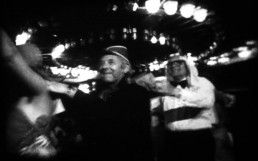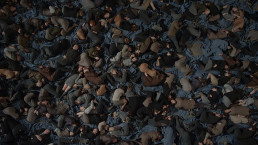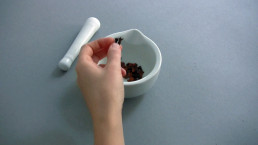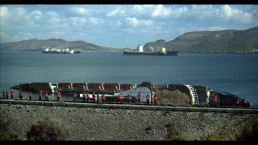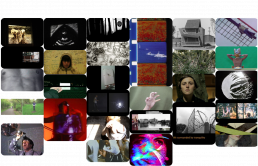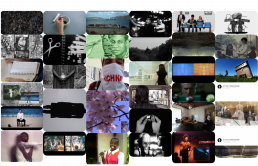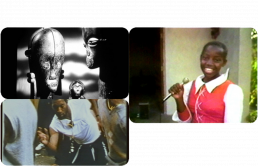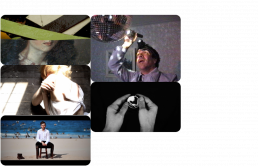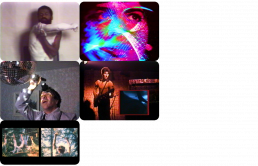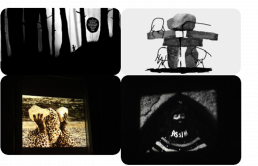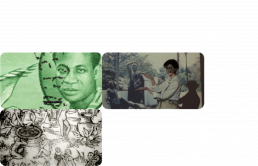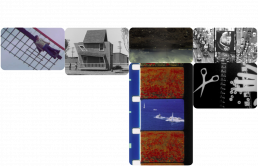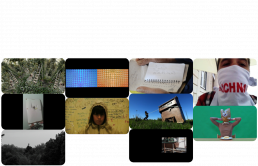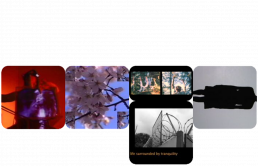“FUSO 2016 – 23 a 28 de Agosto“
Programa
26 Agosto, 23H15
Museu Nacional de Arte Antiga (MNAA)
A Journey on Salted Waters
Curadoria de Daniela Arriado
Duração da sessão 36’
“Não está em nenhum mapa; os verdadeiros lugares nunca estão.”
Ishmael, Moby Dick de Herman Melville
Podemos entender a presente crise migratória como símbolo dos nossos tempos, desafiando a nossa identidade, fronteiras, e para muitos o nosso “projeto Europeu” pós-guerra. Mas durante séculos, desde que os marinheiros conquistaram os Novos Mundos, e ao longo dos tempos, definimos os nossos sonhos e anseios de viajar de porto a porto, entre terra e mar, e por vezes deixámo-los como requiems nas águas salgadas.
Este programa apresenta cinco trabalhos de cinco artistas que exploram a viagem e os símbolos de migração, identidade e esperança.
Dance de Hans Op de Beeck é um vídeo abstrato sobre pessoas em movimento, sobre dizer adeus, sobre poder e impotência e sobre a tragédia do que parece ser a total permutabilidade do indivíduo no grande esquema das coisas. O título em si, Dance (Dança), refere-se à migração como uma coisa instável, movimento ritmicamente irregular, um ato de balançar.
Requiem to a Shipwreck de Janis Rafa foi realizado em honra de um trágico evento na costa Grega. O navio naufragado não é uma relíquia de um incidente fatal, mas uma ruína esquecida na paisagem. Ergue-se como monumento de uma tragédia, e como símbolo dos vários níveis e profundidades do movimento nas águas Mediterrâneas.
Somewhere in Between de Mirelle Borra reflete sobre a diáspora Indo depois da descolonização das Índias Orientais Holandesas (hoje em dia Indonésia). Sublinha diferentes aspetos do processo para redefinir identidade e cultura.
Cruzar un Muro (Cruzar um Muro) de Enrique Ramirez representa metaforicamente, num cenário de ficção e realidade, a espera, a convicção e o direito universal de sonhar, viajar e cruzar fronteiras. Acima de tudo o direito à liberdade de movimento e residência dentro das fronteiras de cada estado e o direito de regressar aos seus países de origem.
The Last Carnival Cruise de Antoni Miralda é uma viagem imaginária inspirada pela indústria do turismo e do lazer, pela velhice e pela ideia de uma viagem sem retorno. Filmado em Super 8 em 1980 por Antoni Miralda a bordo de um cruzeiro. A viagem está relacionada com eventos dramáticos que ocorreram 5 anos depois com o navio Achille Lauro, sequestrado pela Frente de Libertação da Palestina (FLP).
Antoni Miralda, The Last Carnival Cruise, 1980-2016, 9′
The Last Carnival Cruise é uma viagem imaginária pela indústria do turismo e do lazer, pela velhice e pela ideia de viagem sem retorno.
Filmado em Super 8 em 1980 por Antoni Miralda a bordo de um cruzeiro, como parte do seu inacabado projeto By boat, by train and by plane, o vídeo, que foi recentemente editado, é apresentado como um conto de sete episódios: Say Goodbye, Loading Potatoes, Journey Rules, Gogo Food, Enjoyment Tips, Upside Down Rite e Unloading Zone.
O vídeo começa com o navio cruzeiro a zarpar do porto e os passageiros a despedirem-se, seguido de uma visita de iniciação ao navio, realizada como um rito processional pelos corredores, um banquete de doces e uma dança no grande salão de baile. Estas alegres, tumultuosas cenas são seguidas por outras, desertas, com corredores ocupados apenas por malas que, no final da viagem, são descarregadas e arrumadas pela tripulação.
Esta viagem esta relacionada com os dramáticos eventos que ocorreram 5 anos depois com o navio Achille Lauro, sequestrado pela Frente de Libertação da Palestina (FLP).
Cortesia da Galería SENDA, Barcelona
Enrique Ramirez, Cruzar un Muro (Cruzar um Muro), 2012, 5’12’’
Cruzar un Muro (Cruzar um Muro) é um filme, inspirado no 13º Artigo da Declaração Universal dos Direitos Humanos, que afirma “Todo o ser humano tem o direito de deixar qualquer país, inclusive o próprio, e a este regressar”. Neste filme, uma sala de espera de uma repartição pública de imigração, localizada “algures”, é o cenário que converge todas as aspirações humanas do nosso tempo… A espera, a convicção, o desejo e o direito de todos a sonhar, viajar, atravessar, a ter liberdade de movimento e residência dentro das fronteiras de cada estado e o direito de regressar ao seu país de origem… Tudo isto é representado metaforicamente neste cenário entre a ficção e realidade.
Cortesia da Galerie Michel Rein, Paris
Hans Op de Beeck, Dance (Dança), 2013, 9’30”
Dance é um vídeo abstrato sobre pessoas em movimento, sobre dizer adeus, sobre poder e impotência e sobre a tragédia do que parece ser a total permutabilidade do indivíduo no grande esquema das coisas. O título em si, Dance (Dança), refere-se à migração como uma coisa instável, movimento ritmicamente irregular, um ato de balançar. Op de Beeck dirigiu um grupo de 800 voluntários fantasiados num enorme armazém vago. O vídeo foi feito com quatro câmaras em movimento gravado simultaneamente de diferentes ângulos. No filme, os figurantes executam em silencio uma sequência sincronizada de movimentos extremamente simples, como a coreografia das atividades do dia a dia. A banalidade de cada pequeno movimento é ampliada pelo esforço coletivo. Um grupo de centenas de pessoas a tomar banho ou a dormir coletivamente é altamente evocativa. A ausência de um cenário concreto, a falta de texto e narrativa e os movimentos estilizados criam uma atmosfera intrigante. Apesar, ou antes, por causa do olhar neutro dos figurantes enquanto executam as suas ações, as imagens emanam serenidade bem como uma profunda emoção.
Este é um vídeo sobre quem deixa tudo para trás, tanto por que pode ou porque tem. De uma forma subtil, o artista toca tanto na migração voluntária como forçada, nos refugiados à procura de um futuro melhor, mas também à procura de deportação e exílio. O tamanho do grupo de figurantes sugere que a história individual de cada refugiado ou imigrante é, ao mesmo tempo, uma história coletiva.
O indivíduo altamente vulnerável pode ser incentivado por um grupo ou, por outro lado, perder-se nele. O teor destas imagens atemporais é contemplativo e melancólico. Esta solenidade é emoldurada por uma subtrama num ambiente nitidamente contemporâneo, com um menino de oito anos de idade e um homem adulto que toca a música do filme num estúdio de gravação. O rapaz canta uma canção numa língua fictícia, enquanto o homem o acompanha ao piano. A música para este vídeo foi encomendada pelo artista e composta e executada por Johan Hoogewijs.
Cortesia da Galerie Ron Mandos, Amsterdão
Mirelle Borra, Somewhere in Between, 2016, 7’
O vídeo Somewhere in Between reflete sobre a diáspora Indo depois da descolonização das Índias Orientais Holandesas (hoje em dia Indonésia). Centenas de milhares de pessoas de herança euro-asiáticas foram forçadas a deixar o país após o período Bersiap (sangrenta separação entre a Holanda e a sua colónia). A narração do vídeo funde uma série de comentários deixados online em redes comunitárias Indo. Formado como uma corrente de pensamentos, Somewhere in Between destaca diferentes aspetos do processo para redefinir identidade e cultura.
Janis Rafa, Requiem to a Shipwreck, 2015, 5′
Um requiem realizado em honra de um evento trágico na costa Grega. O naufrágio não é uma relíquia de um incidente fatal, mas uma ruína esquecida na paisagem. Ergue-se como monumento de uma tragédia, e como símbolo dos vários níveis e profundidades do movimento nas águas Mediterrâneas.
Cortesia da Galerie Martin Van Zomeren, Amsterdão
“FUSO 2016 – August 23 to 28“
Programa
August 26, 11:15pm
Museu Nacional de Arte Antiga (MNAA)
A Journey on Salted Waters
Curatorship by Daniela Arriado
Total running time 36’
“It is not down in any map; true places never are.”
Ishmael, Herman Melville’s Moby Dick
We might perceive the current migration crisis as a symbol of our times, challenging our identity, borders, and also for many the post-war “European project”. But for centuries, since the seafarers conquered the New Worlds, and through all times, we have set our dreams and longings to travel from harbour to harbour, between land and sea, and sometimes left them as requiems in salted waters.
This program presents five artists and their videos exploring the journey and symbols of migration, identity and hope.
Dance by Hans Op de Beeck is a fairly abstract video about people in motion, about saying goodbye, about power and powerlessness and about the tragedy of what appears to be the total interchangeability of the individual in the grand scheme of things. The title itself, Dance, refers to migration as an unsteady, rhythmically irregular movement, a balancing act.
Requiem to a Shipwreck by Janis Rafa was made to honour a tragic event on the Greek coast. The shipwreck is not a relic of a fatal incident but a forgotten ruin in the landscape. It stands as a monument to tragedy, and a symbol of the many levels and depths of movement in the Mediterranean waters.
Somewhere in Between by Mirelle Borra reflects on the Indo diaspora after the decolonization of the Dutch East Indies (today’s Indonesia). It highlights different aspects of the process to redefine identity and culture.
Cruzar un Muro (Crossing a Wall) by Enrique Ramirez represents metaphorically in a scenario of fiction and reality, the waiting, the conviction, and everyone’s right to dream, travel, and to cross borders. And most off all, the right to freedom of movement and living within the borders of each state or the right to be able to return to their country of origin.
The Last Carnival Cruise by Antoni Miralda is an imaginary trip inspired by the mass tourism and leisure industry, by the elderly age and the idea of a journey with no return. Shot in Super 8 film in 1980 by Miralda while aboard a cruise. The journey is connected to the dramatic events that occurred 5 years later in the Achille Lauro ship, hijacked by the Popular Front for the Liberation of Palestine (PFLP).
Antoni Miralda, The Last Carnival Cruise, 1980-2016, 9′
The Last Carnival Cruise is an imaginary trip inspired by the mass tourism and leisure industry, elderly age and the idea of a journey with no return.
Shot in Super 8 in 1980 by Miralda aboard a cruise, as a part of his unfinished By boat, by train and by plane project, the video, which has recently been edited, is presented as a tale in seven episodes: Say Goodbye, Loading Potatoes, Journey Rules, Gogo Food, Enjoyment Tips, Upside Down Rite and Unloading Zone.
The video opens as the cruise ship sets sail from harbour and the passengers say their farewells, followed by an initiatory visit around the vessel, which is held like a processional rite through the hallways, a banquet of sweets and a dance in the large ballroom. These joyful, tumultuous scenes are followed by other, deserted ones, with hallways occupied only by suitcases which, at the end of the trip, are unloaded and stowed by the crew.
The journey is connected to the dramatic events which occurred 5 years later in the Achille Lauro ship, hijacked by the Popular Front for the Liberation of Palestine (PFLP).
Courtesy of Galería SENDA, Barcelona
Enrique Ramirez, Cruzar un Muro (Crossing a Wall), 2012, 5’12’’
Cruzar un Muro (Crossing a Wall) is a film, inspired in the 13th Article of the Universal Declaration of Human Rights, which affirms that “Everyone has the right to leave any country, including his own, and to return to his country of origin”. In this film, a waiting room, a public office of immigration matters, located “somewhere”, is the scenario that converges all the human aspirations of our time… The waiting, the conviction, the longing, and the right of everyone to dream, to travel, to cross, to have freedom of movement and residence within the borders of each state or the right to return to their country of origin… All this is represented metaphorically in this scenario of fiction and reality.
Courtesy Galerie Michel Rein, Paris
Hans Op de Beeck, Dance, 2013, 9’30’’
Dance is a fairly abstract video about people in motion, about saying goodbye, about power and powerlessness and about the tragedy of what appears to be the total interchangeability of the individual in the grand scheme of things. The title itself, Dance, refers to migration as an unsteady, rhythmically irregular movement, a balancing act. Op de Beeck directed a group of 800 costumed volunteers in a huge, vacant factory warehouse. The video was made with four moving cameras recording simultaneously from different angles. In the film the extras all perform a silent and synchronised sequence of extremely simple movements, like a choreography of everyday activities. The banality of each small movement is magnified by the collective effort. A group of hundreds of collectively showering or sleeping people is highly evocative. The absence of concrete scenery, the lack of text and narrative and the stylized movements create an intriguing atmosphere. Despite, or rather because of the neutral gaze of the extras as they perform their actions, the images exude serenity as well as an undercurrent of profound emotion.
This is a video about who leaves everything behind, either because they can or because they have to. In a subtle way, the artist is touching on both voluntary and forced migration, on the refugee in search of a better future but also on deportation and exile. The size of the group of extras suggests that the individual story of each refugee or migrant is, at the same time, a collective story.
The highly vulnerable individual can be carried by a group or, conversely, lose himself entirely in it. The content of these timeless images is contemplative and melancholic. This solemnity is framed by a subplot in a distinctly contemporary setting, featuring an eight-year-old boy and an adult man who play the film’s soundtrack in a recording studio. The lad sings a song in a fictitious language, while the man accompanies him on piano. The music for this video was commissioned by the artist and composed and performed by Johan Hoogewijs.
Courtesy Galerie Ron Mandos, Amsterdam
Mirelle Borra, Somewhere in Between, 2016, 7’
The video Somewhere in Between reflects on the Indo diaspora after the decolonization of the Dutch East Indies (today’s Indonesia). Hundreds of thousands of people of Eurasian heritage were forced to leave the country after the Bersiap period (the bloody separation between the Netherlands and its colony). The narration of the video conflates a number of comments left on online Indo community networks. Shaped like a stream of thoughts, Somewhere in Between highlights different aspects of the process to redefine identity and culture.
Janis Rafa, Requiem to a Shipwreck, 2015, 5′
A requiem is performed in honour of a tragic event on the Greek coast. The shipwreck is not a relic of a fatal incident but a forgotten ruin in the landscape. It stands as a monument to tragedy, and a symbol of the many levels and depths of movement in the Mediterranean waters.
Courtesy Galerie Martin Van Zomeren, Amsterdam
